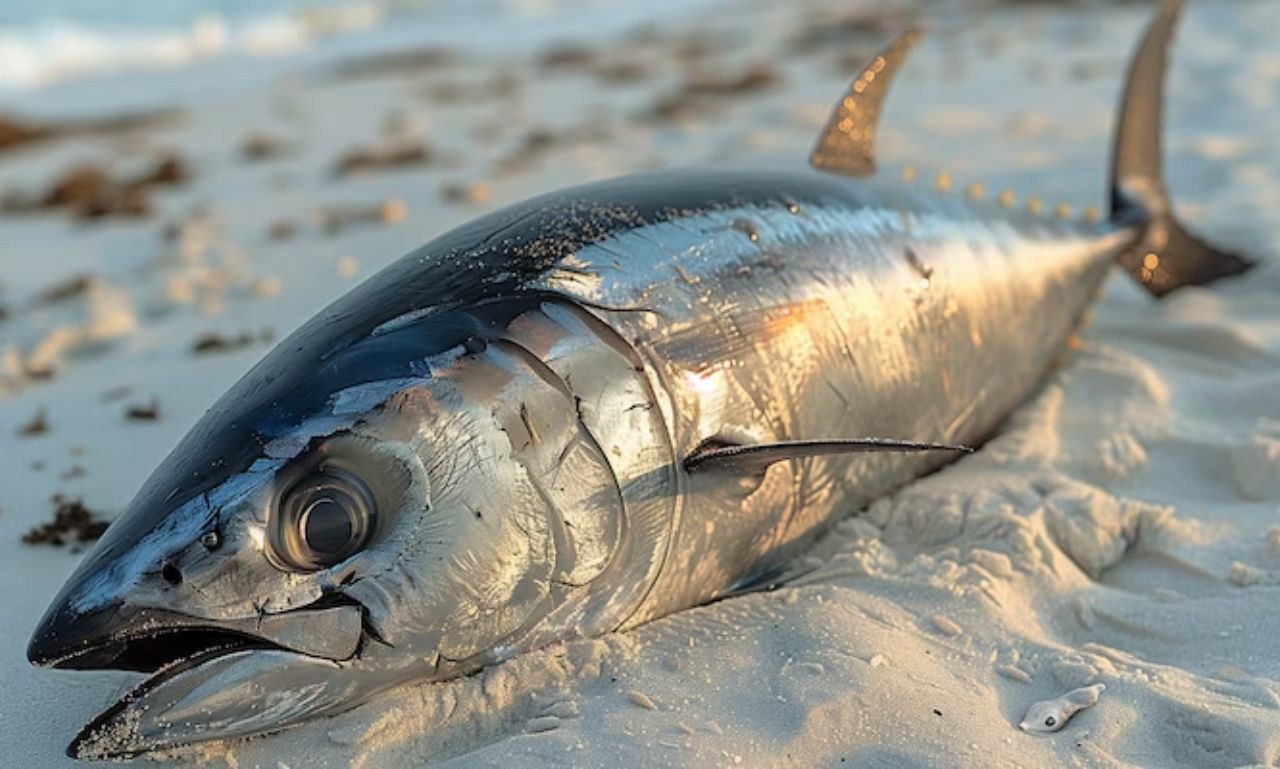Among the many captivating creatures in tropical and subtropical waters, the bluefin trevally (Caranx melampygus) stands out for its stunning appearance, agility, and ecological role. With electric-blue fins and a streamlined silver body, this fish is not only a favorite among anglers but also a subject of interest for marine scientists and reef enthusiasts.
In this comprehensive blog post, you’ll discover everything there is to know about the bluefin trevally—from its habitat and behavior to its role in the ecosystem and importance in recreational fishing. So let’s dive in and explore the remarkable world of this vibrant reef predator.
What is the Bluefin Trevally?
To begin with, the bluefin trevally is a species of large marine fish in the jack family, Carangidae. Found predominantly in tropical waters, it is recognized by its metallic silver body and vibrant blue dorsal, pectoral, and caudal fins—features that make it instantly distinguishable from its relatives.
Scientifically known as Caranx melampygus, the bluefin trevally is not only an agile predator but also an essential part of the coral reef ecosystem. Furthermore, its global distribution and captivating appearance make it a favorite for underwater photographers, sport fishermen, and marine researchers alike.
1. Physical Characteristics: A Blend of Power and Beauty
The bluefin trevally may not be the largest fish in the ocean, yet it is undoubtedly among the most visually stunning. On average, adult bluefin trevally grow up to 80 centimeters (31 inches) in length and can weigh as much as 14 kilograms (30 pounds).
Key Identifying Features:
-
Coloration: Silver to grayish body with electric blue fins.
-
Body Shape: Deep, compressed, and muscular body built for speed.
-
Spots: Often adorned with small black or blue spots scattered across the flanks.
-
Eyes: Large and adapted for spotting prey in clear reef waters.
Notably, juveniles tend to be more vividly colored than adults, making them even more attractive to divers and photographers.
2. Distribution and Habitat

Next, let’s consider where the bluefin trevally thrives. This fish inhabits the Indo-Pacific region, including East Africa, Hawaii, the Indian Ocean, and the western Pacific.
Preferred Habitats:
-
Coral Reefs: A favored zone due to the abundance of prey and hiding spots.
-
Lagoons: Especially for juveniles seeking protection.
-
Open Water: Adults often venture into deeper pelagic zones.
-
Estuaries: Occasionally found in brackish water environments.
Due to their adaptability, bluefin trevally can be found from the intertidal zone down to depths of about 190 meters (620 feet).
3. Diet and Feeding Behavior
Undoubtedly, one of the most fascinating aspects of the bluefin trevally is its feeding strategy. As a carnivorous predator, it preys on a wide variety of reef-dwelling species.
Primary Diet Includes:
-
Small Fish: Such as anchovies, mullets, and goatfish.
-
Crustaceans: Crabs and shrimp form a large part of the diet.
-
Cephalopods: Squid and octopus are often targeted.
Hunting Techniques:
-
Solitary Hunting: Larger individuals often hunt alone.
-
Group Feeding: Sometimes juveniles form groups to chase baitfish.
-
High-Speed Chases: Their powerful bodies and sharp vision make them excellent hunters in open water.
Interestingly, bluefin trevally have been observed using coordinated movements when hunting in schools—demonstrating surprisingly intelligent behavior.
4. Reproduction and Lifecycle
As with many reef fish, the reproductive cycle of the bluefin trevally is linked to environmental cues such as water temperature and moon phases.
Reproductive Characteristics:
-
Spawning Season: Typically occurs during warmer months, although it varies by region.
-
Mass Spawning Events: Large groups gather to simultaneously release eggs and sperm.
-
Eggs: Females produce thousands of eggs per spawning, maximizing survival odds.
-
Larvae: After hatching, larvae drift with currents until they settle in shallow coastal areas.
Juvenile bluefin trevally grow rapidly and begin transitioning into adult habitats within their first year of life.
5. Bluefin Trevally in Sport Fishing
Without question, the bluefin trevally is a coveted game fish for recreational anglers due to its speed, strength, and stunning appearance.
Why Anglers Love It:
-
Aggressive Strikes: Known for hitting lures with ferocity.
-
Powerful Runs: Tests even experienced fishermen.
-
Aesthetics: A beautiful fish to photograph and release.
Top destinations for bluefin trevally fishing include the Maldives, Seychelles, Thailand, and the coasts of Australia. Anglers often use topwater poppers, jigs, and live bait to entice strikes.
Moreover, many regions promote catch-and-release practices to ensure the sustainability of local populations.
6. Ecological Role: More Than Just a Predator
Although the bluefin trevally is best known for its hunting prowess, its role in the reef ecosystem is equally important. As a mid- to top-level predator, it plays a critical role in regulating prey species populations.
Ecosystem Benefits:
-
Population Control: Keeps populations of small fish and crustaceans in check.
-
Reef Health Indicator: A stable bluefin trevally population often reflects a healthy reef system.
-
Prey Distribution: Influences the behavior and distribution of other reef species.
Additionally, the presence of bluefin trevally often signals high biodiversity, making them an important species for ecological studies.
7. Threats and Conservation Concerns
Despite being widespread and abundant, the bluefin trevally is not free from threats. Human activity continues to impact marine ecosystems, posing several risks to this magnificent species.
Key Threats:
-
Overfishing: Both commercial and recreational fishing can deplete populations.
-
Habitat Destruction: Coral reef degradation due to climate change, pollution, and coastal development reduces habitat availability.
-
Bycatch: Sometimes caught unintentionally in nets targeting other species.
Although the bluefin trevally is currently listed as Least Concern by the IUCN, localized declines have prompted calls for improved monitoring and management.
Consequently, conservation measures such as marine protected areas (MPAs) and responsible tourism initiatives are essential.
8. Bluefin Trevally in Culture and Research
Beyond its ecological and recreational importance, the bluefin trevally holds a place in the culture and folklore of several coastal communities.
Cultural Significance:
-
In Hawaiian traditions, the bluefin trevally—known locally as omilu—is respected both as a food source and a symbol of strength.
-
Pacific Island folklore often includes stories featuring the trevally as a wise or cunning character.
Scientific Interest:
-
Marine biologists study its behavior to understand predator-prey dynamics.
-
Fisheries researchers monitor bluefin populations to assess reef health.
Moreover, the fish’s vibrant appearance and relatively predictable behavior make it a frequent subject of underwater photography and nature documentaries.
9. Responsible Tourism and Sustainable Practices
With increasing global interest in marine tourism, it is crucial to promote responsible interactions with species like the .
Tips for Sustainable Practices:
-
Catch and Release: If fishing, use barbless hooks and handle the fish with wet hands.
-
Support Eco-Tours: Choose tour operators that follow sustainable guidelines.
-
Avoid Reef Damage: When snorkeling or diving, never touch or step on coral.
-
Advocate for Marine Protection: Support organizations working to protect reef habitats.
By following these principles, tourists and locals alike can contribute to the preservation of this iconic reef species.
10. Comparing Bluefin Trevally With Other Trevally Species
Lastly, it’s worth comparing the bluefin trevally to its cousins within the Caranx genus, such as the giant trevally and golden trevally.
Bluefin vs. Giant Trevally:
-
Size: The giant trevally is much larger and more powerful.
-
Coloration: Bluefin is more visually striking with its electric-blue fins.
-
Behavior: Bluefins are more frequently seen in schools, especially during adolescence.
Bluefin vs. Golden Trevally:
-
Habitat: Golden trevally often prefer sandy lagoons.
-
Feeding Habits: Golden trevallies are more bottom-oriented feeders.
-
Size and Appearance: The golden trevally has a golden-yellow hue with black bars.
Even though they share a common lineage, each species brings unique value and interest to marine ecosystems and human experiences.
Conclusion: The Bluefin Trevally—A Jewel of the Reef
In conclusion, the bluefin trevally is much more than just a beautiful fish. It is an intelligent hunter, a vital part of marine ecosystems, and a prized target for anglers around the globe. From its dazzling appearance to its ecological role, the continues to capture the imagination of all who encounter it.
Nevertheless, human pressures such as overfishing and habitat degradation threaten its long-term sustainability. That’s why adopting responsible fishing practices, supporting marine conservation efforts, and raising awareness about reef health are more important than ever.
If you ever find yourself snorkeling or diving in a tropical reef, keep an eye out for those shimmering blue fins—you just might witness one of the ocean’s most graceful predators in action.











